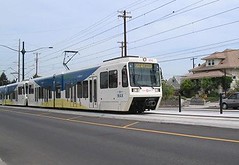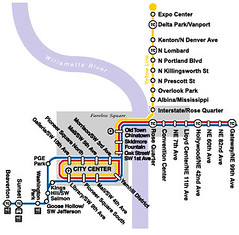Class talk about transit (Baltimore, DC, Portland)
At first I was going to put this in the last entry, which was too long. I have been having an e-conversation with a Baltimore resident who came across the blog. Chris writes:
I came across your blog this evening and I was happy to read your Feb. 26 entry "Poorly designed transit doesn't market transit very well." I'm from Baltimore and I'm staunchly pro-transit, especially rail. I commuted to DC for a couple of years as well, so I'm familiar with transit issues in both cities.
Having discussed this issue with other Baltimoreans, the perceived value of the system (if you want to call it that, considering that the closest transfers between lines are no less than half a block apart) appears to be just one of the factors that has hampered transit support in Baltimore.
Case in point, when designs were being brought forward for rapid transit, one line was originally drawn into Anne Arundel County. If I'm not mistaken, the terminus was to be Marley Station. AA County said no way. And even since the construction of Light Rail, one of the main sentiments I hear coming from the area is that it's brought crime, mostly in the form of property crimes.
Consider the following:
"Citizens and political leaders in Anne Arundel County expressed fears about "undesirable elements" coming into their area via the subway, and many transit buffs cite this as the origin of the term "LOOT rail", a takeoff of "light rail" meaning that criminals without cars who live in the city would take the subway to the suburbs, commit burglaries and robberies, and then take the subway back to the city; and that by building a subway to the suburbs, that such crimes would be greatly facilitated."(Quote from the Roads to the Future website.)
In fact, from discussions I've had and read online, quite a few people in areas like Timonium and Hunt Valley, were not thrilled about the re-opening of Light Rail after the double tracking project. Apparently, crime was down during the time that th eline was closed and MTA was running bus bridges to those areas. Same line of thinking.
It certainly doesn't help that between the Cromwell/BWI Airport and Hunt Valley areas, the line traverses depressed areas that are home to lower class individuals, both white and black. These complaints that I've heard have been touched by both race and class. Apparently, some of the same can be heard from residents living near the northern end of theBaltimore Metro system. Those same arguments tend to be more along class lines.
So, that's what I've seen. I agree with the rest of your post concerning how the poor design has contributed to the lack of appreciation for transit in Baltimore, definitely is on the money.
Ironically, this is the flip side of anti-streetcar arguments in Anacostia, where predominately African-Americans of middle- and lower-incomes see "bringing back streetcars" as designed for whiteys working at Bolling Air Force Base.
I think it's crazy that people can argue against better transit and keep a straight face. But it really shocked me that this has happened, especially after people went on a site visit to Portland Oregon
Although I think part of the problem is that Portland is so homogeneous--read white--that people probably had a difficult time looking past that. They needed to be taken on a tour of Tri-Met's Yellow Line, which had a very difficult gestation, and is a line designed in part to serve as an augur of revitalization for lower income and ethnic communities in northeast Portland.
 Interstate-Yellow Line Tri-Met Light Rail in Portland.
Interstate-Yellow Line Tri-Met Light Rail in Portland. Map of the "poor" area in Portland...
Map of the "poor" area in Portland...One of the people who led the tour that I attended last fall is an African-American property owner in the area--he owns a building or two just up the block from the Widmer craft brewery and down the street from McMenamins White Eagle Rock n' Roll Hotel and a long block from the Albina-Mississippi station--who was originally against the system (because of the way it was funded, through the creation of an urban renewal district, after the failure of either two or three funding referendums).
Now he sees the value and utility of the system, and the positive impact it is having. I joke that he needs to become a transit ambassador for APTA.
My response to Chris:
The story you recount about AA county isn't unusual. The terminus for the main light rail line in Multnomah County (Portland, Oregon) went through the same battle and the local community didn't let the LR line go downtown. Instead, a new business center has developed around the LR terminus.
Note that there is some increase in crime that at the very least is station-related, but that kind of crime happens when a Walmart opens too... But as far as transit related crime goes it seems to go in cycles, as enterprising criminals say from SE DC go up to Rockville on the subway and steal cars. But it's not that frequent, most people who are criminals work close to home, it's the more apt criminals (and there aren't that many) that range farther afield.
Another problem is that the Baltimore region has a very urban renewal (rather than asset-based revitalization) approach to urban revitalization. I.e., Charles Center, Inner Harbor. I haven't read the book yet, but the "memoir" by David Wallace (of Wallace Roberts and Todd) goes into detail about his CC and IH experiences, as he and later his firm were the lead planners for both. I was reading the Baltimore Master Plan revision and while it's great that it has about a 40 page history of Baltimore, the contemporary part, especially that about the urban renewal phase, reads like it was written by pr flacks...
UR seemed to be antithetical to connections. And even though this "red line" is going forward (I've talked to a ZGL consultant who is highly involved in the effort) it will be (yet) another style of LR (more like Portland), different (although that's a good thing) from the current LR system.
The disconnected and "discoordinated" system (a quote from Steve Pinkus) in Baltimore, as you say "hampers" support.
And Chris' response:
On one message board that I frequent, that's been one of the points that anti-transit folks don't want to look at. I'm reminded of an anecdote I read on the same board, during a discussion of Light Rail reopening at Hunt Valley. One of the posters used to work at a department store at the old Golden Ring Mall. One day, he spotted somebody grab some merchandise, then make a break for the door. Outside, there was a car waiting, which the person jumped into, and sped away towards 695, never to be seen again. Not a single anti-transit person would take the anti-highway position, despite its possible use for shoplifting (I-83 isn't that far from Hunt Valley either).
And he quoted from the previously mentioned Sunday Sun article on traffic:
Though Pedersen is, by the nature of his job, an advocate of better roads, he said Marylanders can't expect the state to build its way out of its congestion problems. "We really need to take a multifaceted approach," he said. "You're not going to do it just with building additional highway capacity. We have to look at transit. We have to look at the demand side through programs like telecommuting, and we have to look at land use."
Dan Pontius, regional policy director of the nonprofit Citizens Planning and Housing Association, said Marylanders need more transportation choices. "People are realizing now that the benefit of adding a lane to a highway is pretty short-lived," he said. He said developers need to pay attention to these transportation problems as they design communities, and to try to incorporate walking areas and transit options into their plans.
Index Keywords: transit



0 Comments:
Post a Comment
<< Home